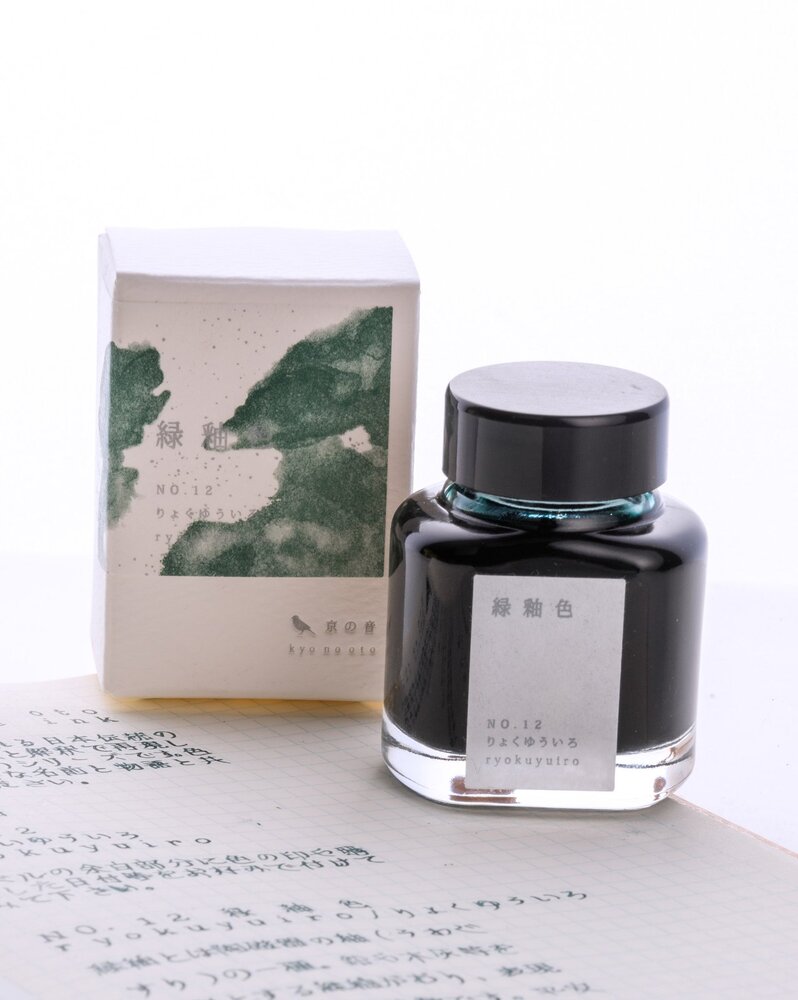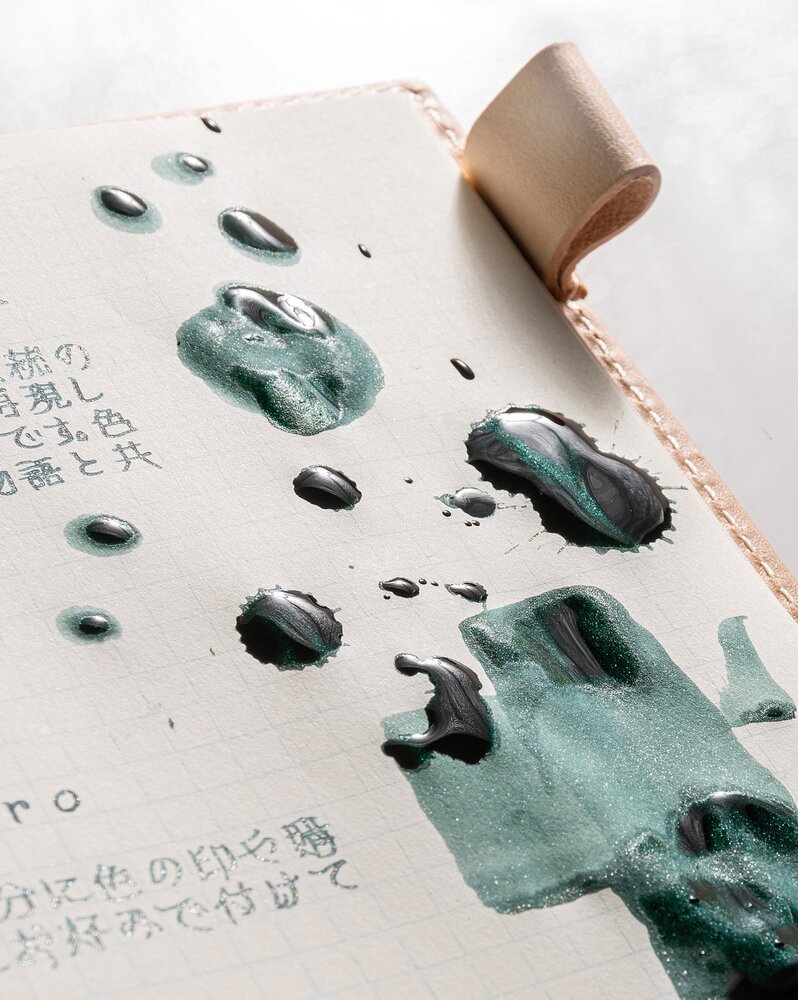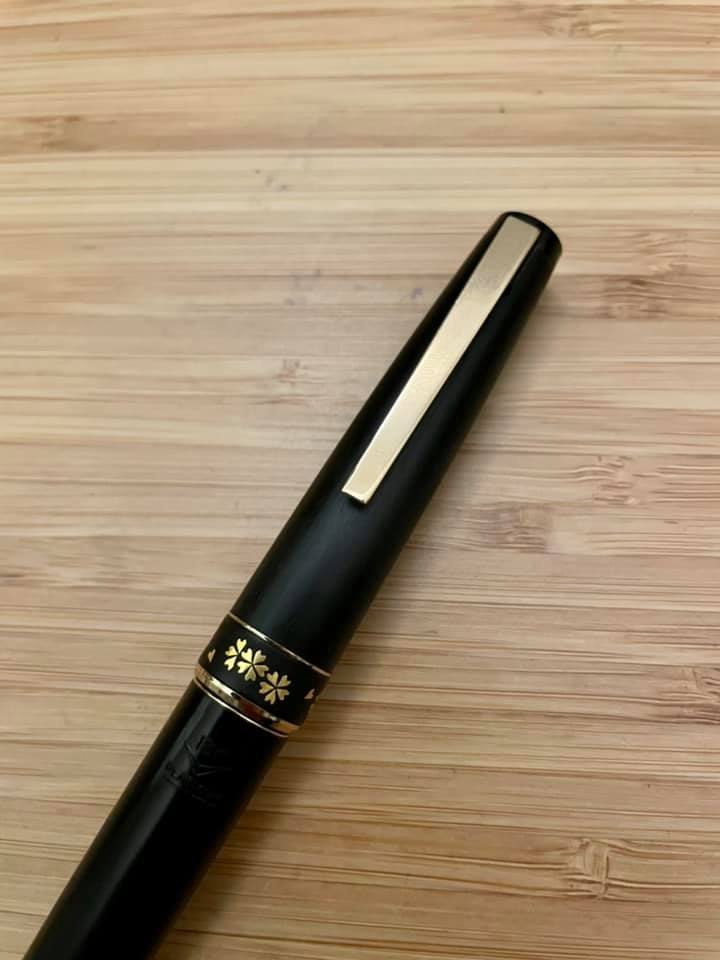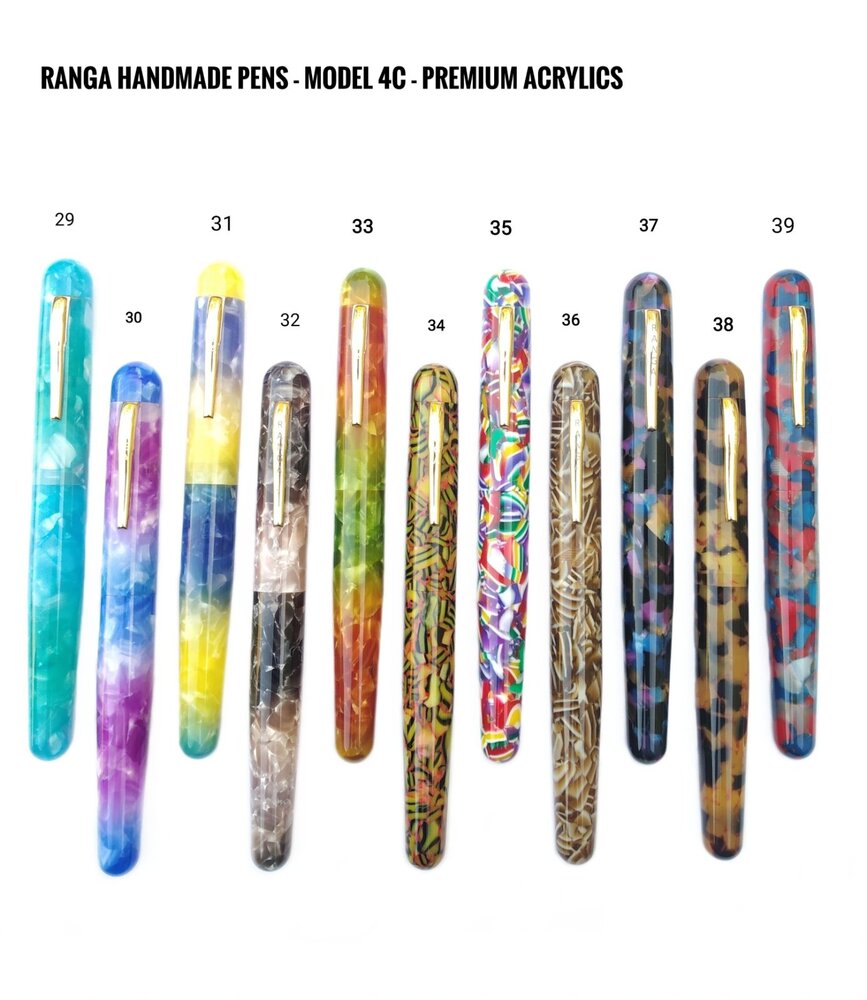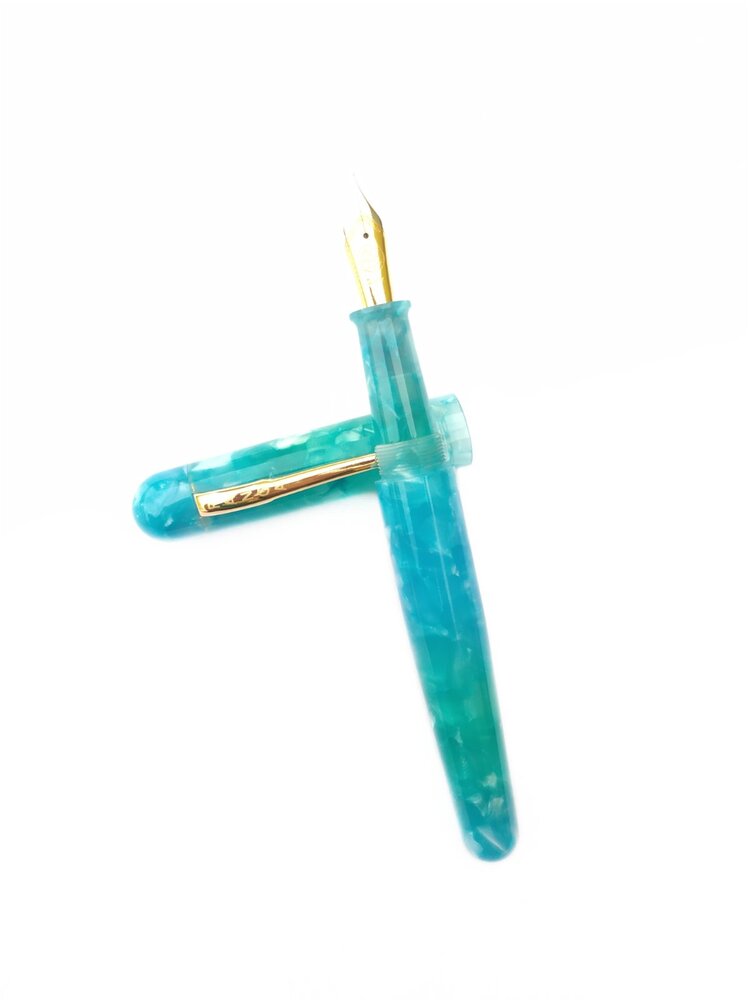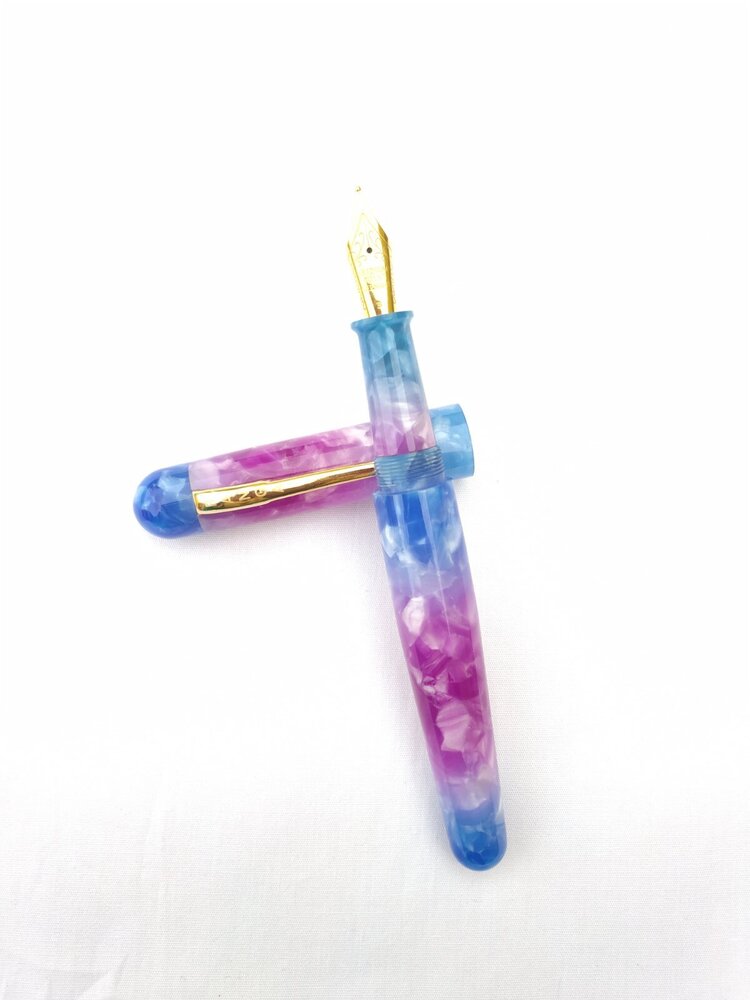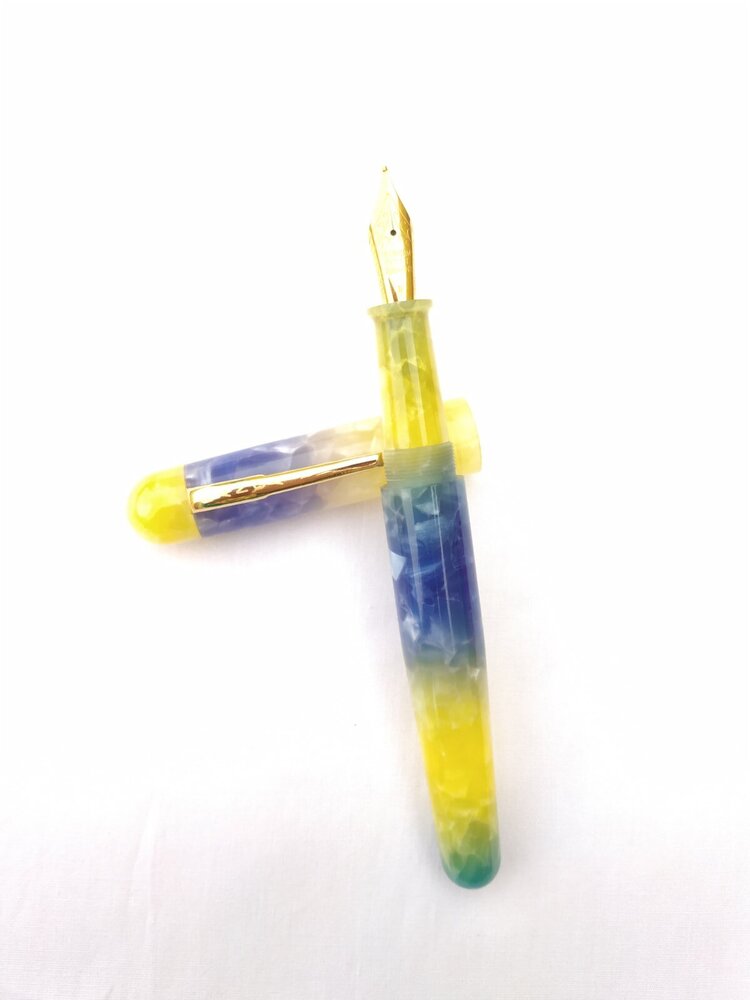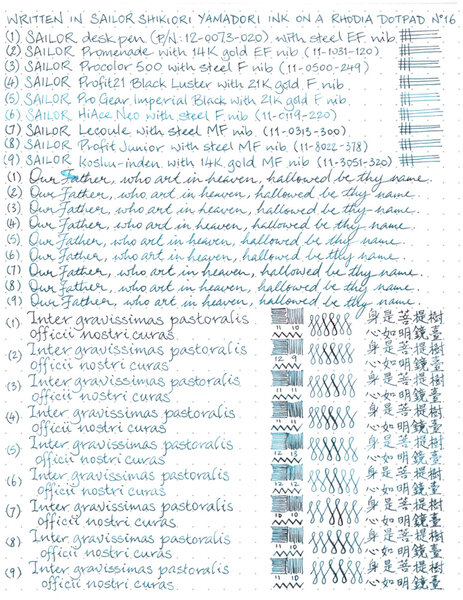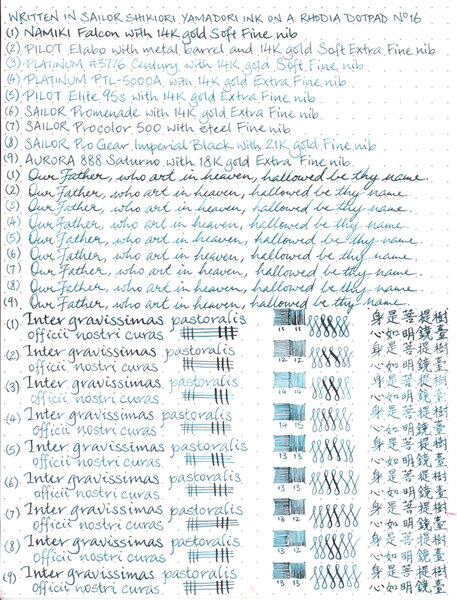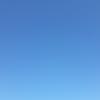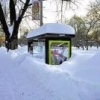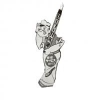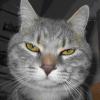Search the Community
Showing results for tags 'japanese'.
-
Once upon a time, around 1980, I owned a rollerball that I’m trying to identify. Rollerballs we’re still pretty new; I don’t remember much about the pen’s ink, but it might have used fountain pen ink (cartridges). What made it uncommon, though, was having a long-short style construction like you see on Pilot Elite, Platinum 200, and several other Japanese fountain pens. Does anyone know of a long short style rollerball from the past? Thanks! Al C
- 4 replies
-
- rollerball
- japanese
-
(and 1 more)
Tagged with:
-
Hi folks I am super new to this hobby. Since I recently completed my first project I would like to post it here and get your eyes on it. Like many of you, I too found the Japanese maki-e fountain pens amazingly beautiful yet very out of my reach price-wise. I had some experience assembling car model kits, so I thought since I already have the spray paint and sandpaper and all that stuff, why not treat a fountain pen just another car model and do some experiments on it? And here's the outcome! Quite honestly, I am pretty happy with the result, although the wood finish I was using doesn't seem super scratch-resistant. Another major issue is that there doesn't seem to be a lot of cheap clip-less fountain pens out there for me to work off. If you folks have any suggestions, please let me know! I bought this one off eBay: Cheers!
-
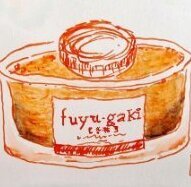
Pilot Lady - Lacquer Over Metal (1970s) 004.jpg
OldTravelingShoe posted a gallery image in FPN Image Albums
From the album: OldTravelingShoe's Random Pics of Japanese Fountain Pens
© (c) 2023 OldTravelingShoe. All rights reserved.
- 0 B
- x
-

Pilot Lady - Lacquer Over Metal (1970s) 002.jpg
OldTravelingShoe posted a gallery image in FPN Image Albums
From the album: OldTravelingShoe's Random Pics of Japanese Fountain Pens
© (c) 2023 OldTravelingShoe. All rights reserved.
- 0 B
- x
-

Pilot Lady - Lacquer Over Metal (1970s) 003.jpg
OldTravelingShoe posted a gallery image in FPN Image Albums
From the album: OldTravelingShoe's Random Pics of Japanese Fountain Pens
© (c) 2023 OldTravelingShoe. All rights reserved.
- 0 B
- x
-

Platinum Bonito + Pilot Lady (1970s) 001 OVERVIEW.jpg
OldTravelingShoe posted a gallery image in FPN Image Albums
From the album: OldTravelingShoe's Random Pics of Japanese Fountain Pens
© (c) 2023 OldTravelingShoe. All rights reserved.
- 0 B
- x
-
desaturated.thumb.gif.5cb70ef1e977aa313d11eea3616aba7d.gif)
Tombow AirPress ballpoint pen
A Smug Dill posted a topic in It Writes, But It Is Not A Fountain Pen ....
I picked these Tombow AirPress ballpoint pens up, as a novelty, recently for roughly AUD 5.40 each‡. The writing instrument's technical design is pretty clever. Instead of using refills that are pressurised during manufacture, like those used in the Fisher Space Pen, the Tombow AirPress ballpoint pen leverages the force applied by the user on the ‘knock’ mechanism that deploys the retractable pen tip, to pressurise the ink chamber on the fly. Filled with an oil-based ink, this product promises (on its retail packaging, marketing images, etc.) to allow rapid writing, write even on wet paper and/or when the page is unsupported from below or when the writing surface is vertical. I just tried writing an entire English paragraph — in a cursive hand, as well as my other, normal handwriting style — on a notebook that I held up with the page facing down, and the pen's tip pointing up, and this pen proved up to the task. The product comes in a variety of colours, and even has a demonstrator version as well as a ‘stealth-look’ version. The barrels on the opaque models are rubbery, and are possibly apt to deteriorate and become tacky to the touch in several years' time. (I'm not sure about the material of the clear barrel, since I haven't opened it yet.) As for the pen's writing output, at first I was apprehensive that the stated, nominal 0.7mm line width would be too wide for my preferences in any sort of everyday application of putting pen to paper. However, the pen actually proved to write as finely as a Japanese EF nib, in fountain pen terms; and it can probably do so in a damn Moleskine notebooks, without being subject to the pitfalls of feathering, etc. All in all, a satisfying purchase for the price, something that could just be tossed into a knapsack as a just-in-case writing instrument and not worry about the jostling or rough and tumble to which it'd be subjected. ‡ Including incremental delivery charges, but not any apportioned international shipping ‘flagfall’ charge for the order, from Amazon Japan. -
Hi everyone, This is a review of the vintage pilot elite (full size). I got it through ebay as NOS and it was pretty cheap since it has a steel gold plated nib and it is made of plastic... And very cheap plastic if you want my opinion... But i was attracted by the look of it and it would complete my collection of elite since I already own the small (Big cap) one. The look : It is actually the best part of this pen in my opinion. It is very subjective of course, everybody won't agree on that but I think it is a very nice pen, black and gold, pretty sharp edges but still a little bit rounded. The golden ELITE word under the cap. Very cool, very stylish, wont go unnoticed ! The nib : I got my Elite with a fine nib ( japanese ) wich would be considered as Extra fine. The nib is nice, gold plated stainless steel but It is very scratchy... It is more than just "feedback" from a very fine nib. So this pen is not my favorite for its writing, I don't use it on a daily basis because of that. The feed : Nothing to say about that... Just good, good ink flow, not too wet not too dry : very reliable, starts up every time and keep going through the pages. Weight and balance : It is a very light pen... it weights about 14g with the converter and ink but it is well balanced, pleasant and comfortable to write with. If you like lighter pens you will appreciate it. Conclusion : It is a good, reliable pen... but it is not very exciting to write with it, the scratchiness of the nib is quite a big issue. I would recommend this pen for a "collector" looking for those types of pen but not as a daily writer.. unless you like very fine and scratchy nibs Despite all this, it is a interesting pen that I got through ebay for very litte money, I still think it is a good buy ! *** English is not my first language so please understand if I made some mistakes ! Your comments are very welcomed !
-
desaturated.thumb.gif.5cb70ef1e977aa313d11eea3616aba7d.gif)
The Lord's Prayer, as writing sample text
A Smug Dill posted a gallery image in Premium Account Albums
From the album: ~Nothing to see here, move along
How well would OCR (optical character recognition) work on this, on account of my mediocre handwriting, as well as writing in different styles? In reply to the discussion here: https://www.fountainpennetwork.com/forum/topic/363267-scanning-app-organization/
- 0 B
- x
-
desaturated.thumb.gif.5cb70ef1e977aa313d11eea3616aba7d.gif)
Q: I Use Western Fine Nibs. What Is The Japanese Equivalent?
A Smug Dill posted a topic in Of Nibs & Tines
Disclaimer: Not my question personally. I have eleven Plaisir and six Preppy pens – with interchangeable sections and nibs, so for the purposes of how ink flows from the cartridge or converter onto the page to form shaped marks by way of the nib, they are identical (to the DPQ-700A desk pen as well) – inked right now, and due to the distinct design of the nib-feed-collector-section, I wouldn't say they are typical or representative of writing with a Japanese fountain pen, manufactured by either Platinum itself or any of the Big Three (Platinum, Pilot and Sailor). The Pilot MR is probably your best bet as try-out models for Japanese steel nibs, as they are often offered very cheaply on Amazon.com, compared to even the domestic Japanese market (in which they're sold as the Pilot Cocoon), if the step-down where the section joins the barrel doesn't bother you. The Pilot Prera, Kakuno, (discontinued) 78G, Penmanship (available with EF nibs only) and Plumix (available with Calligraphy Medium – in other words, italic – nibs only) all share the same type of nib and feed, as do the Pilot P-DPP-1S desk pens, if you prefer a differently shaped or weighted pen. The cheapest Japanese pens with gold nibs are made by Platinum: the KDP-3000A desk pens (with a nominal price of ¥3,000 ex tax), followed by the PTL-5000A models (¥5,000 ex tax), if you prefer to buy and write with gold nibs. Being in the US, you can far more easily avail yourself of grinding services from nibmeisters of renown than most other fountain pen users in the world, so regardless of brand or country of manufacture, you can always just get a nib customised to be your perfect tool of the trade. It would cost someone like me far more to either attend a pen show and engage a nibmeister face to face (and have him or her look at my pen grip and writing technique, in order to adjust accordingly), or send a pen overseas with written instructions, to have a nib modified to my exact requirements and preferences. Now that I have had one pen (out of over 150 in my personal fleet) with a nib customised expertly by Dan Smith, I've become an advocate of after-market customisation services used sparingly, to 'perfect' an crucial asset or resource that one uses for hours on end weekly. Getting a feel for, or even relishing, what each pen manufacturer intended for the writing instruments it produces is a different matter; I can dig the whole "buy a Pelikan for what Pelikan pens are like, and buy a Sailor pen for what Sailor pens are like" thing as a hobbyist, but that's a different matter from acquiring tools of the trade professionally. I was, more than once, unpleasantly surprised by how broad some European pen manufacturers think Extra Fine nibs ought to be, and how thick a line they should make on the page. I'm not just talking about for writing in Chinese hanzi and Japanese kana, either; now that I've learnt more about 'calligraphic' writing in English, I understand that forming each letter of the English letter alphabet with a single pen stroke, much less joining letters to form an entire word in cursive, is not the only way to hand-write in English, irrespective of what they teach in schools in the UK and the US. -
Hello Folks, First time posting here and it might not be a review as per the review standards over here (eg. all the tests and examples etc) but I promise I will make it up with great pictures to showcase the ink. I am mostly active over at reddit and some of the people here might have probably noticed my posts there. Call it a showcase instead of a review if you may. We are talking about one of TAG Stationery's two new inks for 2021 (no.11 & no.12) and I was early enough on the order to get the NO.12 Ryukuyuiro ink. Fresh arrival from Japan just a couple of days back. There is not much information about these new inks yet (atleast in the english forums) except some japanese reviews that I have seen on twitter via TAG's official twitter account. So let's get started on the pictorial journey with a beauty shot as a writing setup on the table. My tools of choice - Midori MD notebook (A5) grid pages & Pilot Custom Heritage 912 (FA nib). The packaging is same as other kyo no oto inks with a variarion of showing ink on the packaging (which has been unique to each ink). It's a shimmering ink, a first for kyo no oto range. Both their new colors are shimmering inks. This one is a deep dark green with silver shimmer. At some angles and how the light falls on the writing, sometimes it feels like there is gold & silver mix. I do not speak or understand japanese, the text written here is a copy from the info leaflet that came along in the box. The ink in its wet glory - unlike most of the kyo no oto inks have been on the drier side, this one feels reasonably wet (initial impressions), good saturation and ofcourse shimmer. I love how most of my inks look on the ivory midori paper. After the dry-down. In this picture it looks like there is silver as well as gold shimmer. Maybe an illusion. On the writing sample the silver is prominent. Jacques Herbin 350 Vert Atlantide seems to be the closest match to this ink. Hope you like my shot, quick post here and would try to make some more posts over here. Thanks for dropping by on my post and if there are any questions I would try my best to answer it here. Cheers, AJ
- 26 replies
-
- ink review
- japanese
-
(and 2 more)
Tagged with:
-
The Original Platinum Higo Zogan (Circa 1969) - A Review
Aelia posted a topic in Fountain Pen Reviews
The original Platinum Higo Zogan was an impulse buy on Ebay. There isn't much information on this pen, but I do know that one blogger (Phthalo) said she enjoyed how this pen writes. I also know that Platinum currently makes a 3776 with a similar higo zogan ring around the cap. Appearance and Design At first glance, this pen is reminiscent of the Lamy 2000 in both shape and feel, but with a Japanese flair. The matte black resin body reminds me of Makrolon but with slightly less of a brushed texture. Its 18K gold nib that looks very similar to that of the Platinum Pocket Pen and other 1970s era Platinum Pens as well as the Platinum Desk Pen. I must say that I’m a fan of the clear vintage era Platinum feeds, especially the clear blue ones found on the Platinum Pocket Pen. This one has a clear black feed. Instead of having the barrel transition seamlessly into the section like on the Lamy 2000, there is a clearly defined ridge that makes it more comfortable for me to hold. The cap includes an understated and beautiful higo zogan ring made of iron and gold formed into the shape of cherry blossoms. The gold mirror polished clip is also reminiscent to that of the Lamy 2000 in form. I have to say that I prefer the brushed clip on the Lamy. Mirror polish or gold plating doesn’t seem to last in my experience. Construction & Quality It’s easy to tell that the Platinum Higo Zogan is a high-quality item. While the plastic and metal parts feel thin, there is a certain presence to the pen when you hold it. Since I’ve only had this pen for about a week, I can’t speak much about its durability. However, given that the pen has went through one full cartridge of ink in the 1970s, and looks practically new after 50 years, I have high hopes for this piece. Weight and Dimensions This pen is relatively large and about the same size as the Lamy 2000. Despite its size, it’s also relatively light, and lighter than the Lamy. Since this pen has a clearly defined section unlike on the Lamy, its additional reference points allow your hands to find a consistent grip on the pen. If you’re like me and you like girthier pens, whether your have large or small hands (like I do), you might like this one. Nib & Performance The 18K gold fine nib is springy and a light touch allows it to float away from the feed. It kind of reminds me of a well-tuned and delicate suspension system. I would not call this a flex nib at all, though it does provide for a tiny bit of line variation. The kanji translates to “Fine Text,” and I have seen other versions of this pen with kanji that reads “Fine Soft.” I would imagine that the Fine Soft version is even springier. I purchased a Platinum Pocket Pen with what I believe to be the same nib but in Fine Soft and I’ll see how it performs and whether they’re interchangeable. This nib is likely equivalent to a modern Platinum F nib. It writes quite wet with J. Herbin Perle Noire and does not skip at all (after I cleaned the feed). The tip provides some feedback as you write, but it's a pleasurable(?) responsive feedback. I’ve found that for a person like me who has a habit of rushing when they write, having some nib feedback encourages me to slow down and focus more on the rhythm of writing. Take my opinion on the nib with a grain of salt because I have never owned another pen with a Japanese gold nib. Filling System & Maintenance The Platinum is a cartridge converter that comes with an "Aerometric" style squeeze-converter; however, since this pen lacks a breather tube, it has trouble taking advantage of what little real estate the sac provides. The stock converter does not fill to satisfaction. I have since switched out the stock squeeze-converter in favor of a modern Platinum piston converter. In addition to having increased ink capacity the gold trim of the modern converter better suits the aesthetics of this very modern looking piece. A part of me wishes that this pen had an integrated piston mechanism instead. There is a lot of real estate in the barrel for ink. Taking apart this pen is very much like taking apart the modern Platinum desk pen. I wouldn’t say it’s too difficult. It was tricky at first since the parts are tightly fitted together. I was actually afraid that a previous owner superglued the pen shut. Luckily, that was not the case. It became easier to disassemble after the first time. I had to clean the pen because it wasn’t feeding from the converter to the feed. After deep cleaning the feed, the pen worked perfectly. Cost & Value For $99 on Ebay, I think this pen was a steal. According to the Platinum website, this pen sold for 8,000 yen in 1970. That is the equivalent to around 27,000 yen ($260.00) today. If we’re evaluating this pen purely for performance, there are many less expensive options that will do the same job. But I do believe that there is value in traditional craftsmanship and I would like to say the pen was worth it. I have never written with a pen that has fit my relatively small hands better than this one. Additional Notes I would post side by side photos with the Lamy 2000, but I have already gifted it to a friend. I also would like to get an experienced 3776 owner to do an A/B. I also want to see if the nib is interchangeable with an 18K Fine Soft nib from a Platinum Pocket Pen with the diamond inlay. Would you folks recommend that I don’t swap out the nibs? -
Dear FPN'ers, Greetings !!! This is Kandan.M.P from Ranga Pen Company, India. Hope and wish you are staying safe . Thanks for your support so far This group buy is for RANGA Handmade Pens Model 4C in beautiful Premium Acrylic resins. The pens are completely handcrafted from high quality blanks made in Taiwan. Acrylics are glossy, attractive and Visually stunning This is beautiful Cigar Shaped Pen in seamless finish. It is one of the Popular Ranga Model Pen. It caps in less than 1 turn. Capped Length - Approximately 5.75 Inches Cap Dia - 16mm, Barrel Dia - 16mm, Section Dia - 12.5mm at Thickest part and 11mm at lowest part. In order to purchase Ranga Model 4C Pen , Kindly fill the Google Form (Link Below) RANGA Model 4C - ORDER FORM ---------------------------------- https://docs.google.com/forms/d/e/1FAIpQLSdjBG1FO-PtNsnYyWjmNtMzdTKyvuufuC7Hpxc8m_sWnStlow/viewform?vc=0&c=0&w=1&flr=0 Prices are as follows: RANGA Model 4C with Ranga Nib and German Schmidt Converter: 74USD (Its Regular Price is 89USD). Kindly avail this Offer Price for this Excellent Pen You can upgrade it with German Bock/Jowo/Schmidt Screw in Nib and German Schmidt Converter. Up-gradation charges are mentioned in Google order form Colours : Premium Acrylics: ------------------------ 29 – Turquoise Green Parfait 30. Blue Purple Parfait 31. Yellow Blue Parfait 32. Iced Mocha 33. Green Orange Parfait 34. Bengal Tiger 35. Kaleidoscope Weave 36. Classic Tigress 37. Vegas Nights 38. Tortuga 39. Cardinal Tetra Finish :Polished Finish or Matte Finish Clip Option - 1. Gold Clip 2. White Clip 3. Clipless Cap Turn: It takes less than 1 turn to cap and uncap For C/C mechanism (with Schmidt K5 Converter) #6 Nib Options Nib Option: Ranga Extra Fine Nib - Chrome Tone ,Gold Tone,Dual Tone Ranga Fine Nib- Chrome Tone ,Gold Tone,Dual Tone Ranga Medium Nib- Chrome Tone ,Gold Tone,Dual Tone Ranga Broad Nib- Chrome Tone ,Gold Tone,Dual Tone Ranga Double Broad Nib:Chrome Tone ,Gold Tone,Dual Tone Ranga Flex: Chrome Tone ,Gold Tone,Dual Tone Ranga 14K Nib # 6 Size Nibs:- Extra Fine, Fine Point, Medium Point ,Broad Point, Flex Bock Titanium #6 nibs: Fine Point, Broad Point, Double Broad Point Bock 18K Nib # 6 Size Nibs:- Extra Fine, Fine Point, Medium Point ,Broad Point, JoWo Fine Nib - Chrome Tone or Gold Tone JoWo Medium Nib - Chrome Tone or Gold Tone JoWo Broad Nib - Chrome Tone or Gold Tone JoWo 1.1 Calligraphy Nib - Chrome Tone or Gold Tone JoWo 1.5 Calligraphy Nib - Chrome Tone or Gold Tone Schmidt Fine Nib - Gold Tone or Chrome Tone Schmidt Medium Nib - Gold Tone or Chrome Tone Schmidt Broad Nib - Gold Tone or Chrome Tone No Nib - Threaded for Bock #6 No Nib - Threaded for JoWo #6 No Nib - Threaded for Schmidt #6 Price : Base price for Ranga Model 4C with Ranga Screw in nib and German Schmidt Converter is 74USD (Premium Acrylic) Customer's can upgrade it to their favourite nibs with extra charge Making Time : 2-3 weeks from payment date Shipping: Via Courier . It takes 4 to 9 days.Via Courier- Kindly note that courier rates are very high now. We are happy to share that we are collecting only 50% of the courier charges and rest is incurred by us . Customer's need to pay 15USD for USA/Canada, 10USD for Central Europe /Singapore/ Malaysia and country specific rates for other countries. Making Time: 2-3 Weeks after payment Payment Details: Paypal id: mpkandan@gmail.com If you buy More than 2 Pens and if you don't want to fill the form, You can directly send the specs to our mail id mpkandan@yahoo.co.in Regards, Kandan.M.P Ranga Pen Company
-
desaturated.thumb.gif.5cb70ef1e977aa313d11eea3616aba7d.gif)
Writing samples with nine Sailor pens in yamadori.jpg
A Smug Dill posted a gallery image in FPN Image Albums
-
desaturated.thumb.gif.5cb70ef1e977aa313d11eea3616aba7d.gif)
Writing samples with six other pens in yamadori.jpg
A Smug Dill posted a gallery image in FPN Image Albums
-
Storio Wooden Fountain Pen Case Review
ace117 posted a topic in Paper & Pen Paraphernalia Reviews and Articles
Hey guys! During my recent travels to Japan, i found a unique wooden fountain pen case from Storio. I'd never heard of the brand before but the moment i saw the case i fell in love with the way it looked and felt, so I just had to get one! I thought I'd just shed some light on this relatively unknown brand, as i think this case is beautiful and worth every penny. It looks professional and sleek/ stealthy, yet is interesting enough to get anyone who lays eyes on it to start a conversation about it! If you guys are interested, i made a video review about it! Theres also a link to where to get one if youre interested! Let me know if you guys have any questions or comments about it! Edit; There seems to be an issue with the audio. I will update the post when i reupload a new one! Edit 2; Audio issue has been resolved! -
First of all I want to mention this review by FPN user sova featuring stunning photos of the Turquoise blue Platinum Procyon. In my opinion the Platinum Procyon receives less attention than it deserves, thus I decided to write a review. I want to provide some information, share my experience using it daily and also take a look at why it might be not hugely popular. Introduction This review is meant to depict my personal opinion and valuation, thus I don't want to use points to rate aspects. Surely comparability is an advantage which makes using points worth considering, but neither am I an expert for the standards used nor could I compare a pen to dozens of first hand experiences with other pens. And frankly speaking in my eyes many reviews aren't objective which to me relativises the value of scores. Because of that I will try my best to describe my experience with this Procyon in a way which allows you to contrast it to your experiences and preferences. Platinum introduced this model in the summer of 2018 and named it after Procyon, the brightest star in the constellation of Canis Minor who in turn got its name from rising before Sirius, the brightest star visible in the night sky. Sirius is also known as dog star. Procyon stands for a distant relatives of dogs, too, the racoon. Hopefully the pictures I took will remind you more of a clear night sky than a racoon however. First Impressions My pen came in a black carboard box along with four cartridges. Platinum specially created three inks called Gold Ochre, Aqua Emerald and Dark Violet which accompanied the Procyon along with a instruction on how to recreate them yourself and a regular blue-black cartridge. Unfortunately this pen doesn't include a converter. The packaging is utilitarian, the unique ink cartridges are nice but I would have prefered a converter. This pen comes in five colours called Deap see, Porcelain white, Turquoise blue, Persimmon orange and Citrus yellow ranging from understated to pretty colourful. The dark blue doesn't attract attention, taking a closer look however reveils its twinkling. According to Platinum this colour is inspired by the deep sea, I link it to the stars. It has about the size of a Lamy Safari and feels solid. Appearance & Construction The Procyon's body and cap are made from laquered aluminium. The Deap See's base layer is of deep blue on which aluminium flake powder was added which gives the blue depth and creates twinkling. In a dark environment the sky-laquer of this pen resembles a starless night, with more light it becomes reminiscent of a clear night which allows one to see thousands of stars. The white one's laquer is smooth and shiny while the colourful versions feature matte laquer. The trim is silver coloured. "Procyon" and "Platinum Made in Japan" are written on the cap in capital latters. Its grip is made from semi-translucent dark grey plastic. Metal threads on both the grip and the body make a stury, long-lasting impression. Furthermore the threads are rectangular making them pleasant to touch. Usually the nib has a good chance to be the most interesting part and I don't want to say this one isn't but it isn't spectacular visually. It looks similar to nib the Preppy, Plaisir and Prefounte use but is larger. It lacks a breather hole and adornment is limited to Platinum's logo and a F or M indicating the nib size. Platinum proudly advertised this pen's new feed as it is able to draw ink from a hole below the nib at about half of the nib's length. This allows you to more easily fill your pen and use up bottled ink because to don't need to insert the entire nib into ink. Cleaning the pen after filling thus also becomes easier. My feed shows signs of Sailor Seiboku. Usually its black and clean. Besides this the Procyon also features the inner cap known from the 3776 Century which is supposed to prevent ink from drying out for up to two years. I didn't test that but notice its effect in comparison to a Waterman Hemisphere for example which lacks a inner cap. In the Hemisphere ink becomes less keen for writing for the first few letters after a day. Thanks to the inner cap this is no problem with the Procyon even with more difficult inks. Two things I don't like: I find the grey material below the semi-translucent plastic of the grip makes this part a bit cheap. I carry my pen in a pencil case in which there is no scissors, only pencils, two ballpoints and markers and treat it carefully but at the end of the barrel the laquer is coming of where the barrel transitions into the end finial as well as in one place on the barrel. That's disappointing to me and makes me apprehensive of the laquers future. Nib and Performance The nib is made from steel. Platinum claims the pentagon shape makes writing feel similar to a gold nib without much explanation of what exactly they imply. It is not soft or flexy but very stiff. As you might expect from a Japanese nib it runs relatively fine. The nib provides some even feedback and is audible when writing. It has medium flow and works very reliably, starts easily every time and feels controlled to me. There is no beautiful adornment but it works. Reverse writing is possible, makes for a very fine line. The flow keeps up well. Filling System and Maintenance Platinum uses a proprietary cartridge/converter system. I find their cartridges and converters to be of high quality and work reliably. While the cartridges contain quite a lot of ink I wished for a bigger converter. As I mentioned above there is no converter included. The converter's mouth is reinforced by a metal collar. Cost and Value The Procyon retails for around 50 US Dollars to 70 Euros. This makes it one of the more expensive steel-nibbed pens and maybe also is the reason it is less often recommended than other competitiors. There is a lot of competition in this price range. Lamy and Pilot for example both offer several pens up to this price range and at least in Europe you are also able to get a Pelikan M200 for this price. Additionally the Procyon will also compete with its new sibling, the Curidas. I think this Platinum has a lot to offer: a very reliable nib, good size and weight generally speaking, a handy feed, an excellent inner cap and a sturdy body. Its features are very reasonable and utilitarian, but maybe not flashy enough to stand out. Conclusion If you are looking for a understated, reliable next-level pen to accompany you in daily life and like its design, you will probably soon appreciate its qualities.
-
To all those who own (tried) both pens, i would like to ask why are western nibs (pelikans specifically) are know to be wetter than the Japanese nibs (considering same nib width on paper and not marking) . Is it because of the feed/nib material or the engineering of the feed/nib ?
-
Wancher has launched a kickstarter for a series of fountain pens with the name Seven Treasures. They are made from Bakelite and feature Shippoyaki; Japanese Cloisonne artwork. Current super early bird reward is at $240 for the basic version with steel nib and plastic feed. Black ebonite feed is an aditional $30 Red ebonite feed is +$50 Gold nib is +$130 https://www.kickstarter.com/projects/wancher/seven-treasures
- 21 replies
-
- seven treasures
- japanese
-
(and 3 more)
Tagged with:
-
During this post I'll be referring to the pictures in this dropbox folder: https://www.dropbox.com/sh/11qy002u9zm30q1/AAD85vSlKVXkNeYE37ZG_GyRa?dl=0 While browsing some antique shops I stumbled across this interesting set. After a bit of googling, the jumbo pen matches what many threads are calling a 1950's jumbo tourist / souvenir pen from Japan. The big guy is in pretty good shape and functions fine. The clip says "New Clip" and the nib says "Special Ideal Pen". The body feels almost like it's made of wood. The painted details have major cities in Japan labeled in English. What really caught my eye is the tiny, gourd-shaped pen. It seems to be a part of a set with the larger one, since the painting style is very similar. Has anyone seen this thing before? A cursory google search didn't help. Of course, there are also no real "brand" markings on the pen itself. The only marking is on the nib which seems to say "WHiNPER" (really looks more like "WH|NPER", with the bar being about half-character height). That's the only brand marking I can see. (It does also say "IRIDIUM"). The body also seems to be made of the same material as the larger pen. I tried to figure out the filling mechanism for the small pen. The nib and collar could rotate about 90 degrees and there are two orange dots that can line up. After trying for a while, something snapped and the whole nib section came out. I then fished out some rotten rubber from inside the pen. I think I may have also broken a plastic piece connected to the collar? I can't really tell very well. Does anyone know how this little thing probably used to be filled? Also, if there are any ideas for how to maybe repair it (if at all possible), I'd quite appreciate it. I'd really like to see it functioning.
-
I bought a naginata togi back in september of 2014, after 6 months of trying, I'm still not comfortable or finding a nice surprise with the nib. I tried to practice chinese penmanship with it, which is what the nib was designed for, but I find it much harder to use than a regular or soft nib, even a Noodler flex was easier to do asian calligraphy with. Or the stroke just looks odd. Am I using it wrong? Anyone have any advice on how to properly use the naginata togi? Or tricks to control the nib more easily? Giving this another 6 months and if nothing works, I'm probably going to sell it.
-
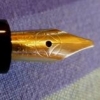
Life Noble, Davinci (Tomoe River), Or Other Planner Refills?
truthpil posted a topic in Paper and Pen Paraphernalia
Hello again to all my FPN friends, I just purchased a leather A6 6-ring planner (same size as Filofax Personal or Daytimer #3) that I'm going to use for a project that needs to have somewhat archival paper (basically, the pages and what's on them need to do their job for at least the next 50 years amidst daily use). The paper that the planner came with feels like writing on sandpaper, so I desperately need something else. So far the best paper I've come across seems to be Life Noble and DaVinci (which uses 52gms Tomoe River paper). For my project, the planner refill paper needs these three qualities, in order of importance: 1. Fountain pen friendly - Minimal-to-no bleed through or feathering with a fine or medium nib and waterproof inks like Sailor Sei-boku, Platinum Carbon Black, and De Atramentis Document inks. 2. Durability - Pages need to be able to withstand regular thumbing through over decades without curling up (discoloration is to be expected) 3. Opacity - As much as is possible, I would like to be able to read both sides of the paper in various lighting without the text on the other side of the page getting in the way. Given those considerations, can anyone who has used the aforementioned filler papers let me know how they fare? Here are the two options I'm looking at: Additionally, I'm totally open to any other suggestions for fountain pen friendly planner refills. I'd rather not make my own. Many thanks for any assistance! -
Hi FPN, I am trying to learn the history and information on this pen stamped Hosei. It is a Japanese eyedropper with sealing rod. The barrel is stamped: Hosei / Sanshin & Co.,PT / Tokyo. The nib is stamped: Special / Hosei / Ideal / JIS / 4366. The cap band is stamped: R14K. I did not see Hosei under the topic: Pen Manufacturers - Current and Past, so does anyone know anything about this pen? Thanks in advance everyone.
-
Greetings, from Minnesota! My name is Matthew, and yesterday i picked up a box of artifacts belonging to a U.S. Army Engineer who served in the Pacific Theater during World War II. Inside the box were many captured Japanese items with one of those items being a pen! The pen was wrapped up in cardboard with a label "Japanese Pen' written on the outside. Attached below are some pictures showing what i found. I'm looking for any information on this pen such as era, construction and if it's anything special. Thank you, -Matthew 2 B2E88A7-B556-4946-BD72-48F5D816C84B by Matthew Stone, on Flickr 743B41EE-D249-44B3-A9DC-7C7305D3AB85 by Matthew Stone, on Flickr 81178DB0-6D43-4B44-82EC-7F5F48947014 by Matthew Stone, on Flickr 720DA50A-F629-46A4-B227-20B71C90A105 by Matthew Stone, on Flickr 51327ABC-EF40-422B-8FB0-7725BCA21F1F by Matthew Stone, on Flickr 60C1D3D8-5DCC-464F-9824-2137671A56AE by Matthew Stone, on Flickr 11879090-F10F-4DBF-A904-EE5B008740EE by Matthew Stone, on Flickr BFC372DC-1659-4457-BADA-A748BCF9C564 by Matthew Stone, on Flickr 004A72CE-E85F-48A9-A94E-79AEBB6AE112 by Matthew Stone, on Flickr
-
I am going through my (too many) pens before deciding which pens I will give away or sell or simply store in the attics. Part 1: Ohto Tasche - a pocket pen from Japan. https://mkepens.blogspot.com/2018/07/not-expensive-pen-1-ohto-tasche-ff-10t.html Conclusion: it is a not expensive pen which I can theoretically* recommend. * Personally, however, I prefer the MB149-sized pens, even for pockets. (No advertisement, I own the pen.)
- 1 reply
-
- pocket pen
- japanese
-
(and 1 more)
Tagged with:



004.jpg.f080c3c62f8f8511491defeea9116087.jpg)
002.jpg.1fb408e9fd90762356f84c519db94511.jpg)
003.jpg.686d632c79c1176098786e67d8353dae.jpg)
001OVERVIEW.jpg.fef308b26a915fffe511d91da2f0f526.jpg)





.jpg.da646567bc3127c52d58f1e0c3e0ca2e.jpg)



